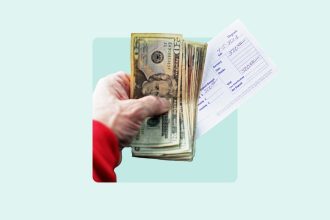We all know that inflation has greatly affected our purchasing power in recent years. Prices have risen an average of 22.7 percent since the beginning of 2021 and wages have grown 21.5 percent, according to Bankrate’s 2025 Wage to Inflation Index.
This is a major contributor to the low consumer sentiment readings reported by the University of Michigan, The Conference Board and other popular indicators. By and large, even if you’re working and your wages are going up, you don’t feel like you’re getting ahead because your costs are rising even more.
Sadly, the news doesn’t get much better when it comes to another form of “currency” you might have at your disposal. What you might not realize is that inflation is affecting your credit card rewards, too.
Spending caps haven’t budged
What you might not realize is that inflation is affecting your credit card rewards, too. For starters, spending caps haven’t kept pace with rising prices. I love that the Blue Cash Preferred® Card from American Express gives 6 percent cash back at U.S. supermarkets. I don’t love that the elevated rewards are capped at $6,000 in annual spending — the same threshold that has existed since 2013. Purchases beyond the limit only earn 1 percent cash back.
Adjusted for inflation, $6,000 in 2013 equates to $8,344 today, according to USInflationCalculator.com. Because the spending cap hasn’t gone up, this essentially means that the promotion is worth 39 percent less now than it was 12 years ago.
The same issue is affecting many other popular credit cards, including popular rotating category cards such as the Chase Freedom Flex®* and the Discover it® Cash Back card.
My biggest credit card industry pet peeve is that these limits should be periodically adjusted for inflation.
Travel redemption values now correlate with prices
Another example of inflation affecting credit card rewards is the abandonment of fixed award charts in favor of price-based valuations. Not too long ago, it might have cost 25,000 miles for a reward flight anywhere within the U.S. It didn’t matter if that flight cost $100 or $500. Now, it’s much more common to encounter fare-based redemptions like a $250 flight for 25,000 miles and a $500 flight for 50,000 miles (1 cent per mile in each example).
Further, earning those miles has also become much more about how many dollars you spend (on flights and on the airline’s co-branded credit card), rather than how many miles you fly. Delta was the first major airline to do away with fixed award charts, in 2015. United followed suit in 2019 and American Airlines did so in 2023. In recent years, almost all major airlines have made the switch to dynamic pricing, which means you earn miles based on the fare-class or how much you pay and not the distance flown.
This was a consumer-unfriendly change to begin with, and sharply higher prices have made it even worse.
Most large hotel chains have done the same thing, creating a direct link between points and prices which requires more rewards points for pricier stays. Big players such as Marriott and Hilton have done away with formal award charts entirely. You used to be able to see, for example, that a standard Category 1 redemption (a cheaper hotel) might have cost 7,500 points per night. A pricier Category 5 redemption could have required 35,000 points for a standard reward night. While it has long been the case that more expensive stays require more rewards points, the loopholes are essentially gone.
Previously, you might have been able to nab that Category 5 night for 35,000 points on a standard night and 40,000 points during peak season. But on a night when a major concert or sporting event was in town, the price of the room might have been $600, making your 40,000 points worth 1.5 cents apiece. Now, with a fixed scale that adjusts in line with pricing, our points and miles valuations peg Marriott points at just 0.7 cents apiece and Hilton Honors points at 0.6 cents each.
Different rewards programs represent different currencies
It’s important to understand that rewards points and miles are currencies. Just like dollars, euros and yen, Delta SkyMiles are a distinct currency from Chase Ultimate Rewards and Hilton Honors points (to name a few).
The pandemic led to a big shift in how airlines and hotels, in particular, value these rewards points and miles. From an accounting perspective, rewards points are a liability for airlines, hotels and credit card issuers. They’re a valuable marketing tool, of course, but they show up on the profit and loss statement as a liability. Essentially, outstanding points and miles are an IOU. It’s similar to how retailers account for gift cards, loyalty providers need to make good on that promise at some point. And they want to do so in a way that’s most favorable to them.
United Airlines said the quiet part out loud in 2020, during the depths of the COVID-19 crisis. With travel at a halt and the airline’s business model in jeopardy, United secured $5 billion in loans by putting its loyalty program on the line as collateral. And, yes, these rewards programs are worth billions of dollars by themselves, leading U.S. Sen. Dick Durbin (D-Ill.) to quip that airlines, “have become credit card companies that also happen to own airplanes.”
In its investor presentation, United provided a tremendous amount of detail into how it makes money from its loyalty program, including advantages such as “the ability to adjust price and influence redemption of miles” and “ability to maintain margins.” In other words, the airline can play with the value of its currency (MileagePlus miles). If it chooses, it can require more miles for a free flight in the future (something virtually all airlines have done), and it can prioritize paying customers over rewards users.
The shift to frequent spender programs
In fact, so many points and miles are earned via spending these days that the system is awash in rewards and travel suppliers are looking to liquidate these points and miles in ways that are more favorable to them. Brian Kelly, founder of “The Points Guy,” (which, like Bankrate is owned by Red Ventures), is fond of saying that rewards programs have become “frequent spender programs,” as opposed to the traditional moniker of frequent flyer programs.
Case in point: American Express paid Delta $6.8 billion in 2023, according to CNBC. This is a common arrangement across the industry — card issuers buy rewards points/miles from travel suppliers and use them as marketing incentives to acquire and retain cardholders. Card issuers also share some of the spoils with their co-branded credit card partners (such as airlines, hotels and retailers). This could include “finders’ fees” for bringing in business, lower processing costs and perhaps a share of fee revenue.
“To give a sense of scale, Delta CEO Ed Bastian told investors in June [2023] that roughly 1 percent of the entire U.S. economy is spend on Delta’s credit cards,” CNBC wrote.
That’s an incredible illustration of the tremendous scale that we’re talking about here.
What this all means for you
Sometimes, the rewards game feels a bit like a casino. As in, the house always wins. But it doesn’t have to be that way. Even though many rewards programs aren’t as valuable to consumers as they used to be (even a few years ago), these programs still offer considerable value — if you play your cards right.
It all starts with paying your credit cards in full every month. The average credit card rate as of early October is 20.03 percent, which is way more than the typical rewards payout. You’d be lucky (and skilled) to earn a blended 3 percent rewards return across all of your credit card spending. Just over half of credit cardholders typically pay their entire statement balances each month, according to Bankrate’s 2025 Credit Card Debt Report. These are the best candidates for rewards.
In some respects, as long as you’re avoiding interest and refraining from overspending, any rewards you earn are a bonus. Of course, some redemptions are valued much more highly than others. If you know what you’re doing and if you have the flexibility to travel on the optimal dates, it’s still possible to get something like an $8,000 first-class airline ticket for 100,000 points (a whopping 8 cents per point). Conversely, you might only get 1 cent per point if you redeem for cash back. Or even less (perhaps 0.6 to 0.8 cents per point) if you redeem for merchandise at Amazon.com or another retailer.
The bottom line
While inflation is eroding some of the value of credit card, airline and hotel loyalty programs, it’s still possible to get good benefits from these programs. You might just need to work a little harder than you did previously.
You need to know yourself in terms of how you spend and what you’re looking to get out of your rewards and how much work you’re willing to put into your credit card strategy. Travel credit cards are often more lucrative than cash back cards, but they also tend to require more legwork to nab the most value, and they’re more likely to charge annual fees. Cash back is Americans’ favorite credit card feature because it’s simpler and more straightforward. Who couldn’t use more cash, right?
If nothing else, sign up for free loyalty programs offered by airlines, hotel chains, grocery stores, gas stations, restaurants, retailers and more. If you’re going to spend the money anyway, you might as well see if you can get something free in return.
Have a question about credit cards? E-mail me at [email protected] and I’d be happy to help.
Why we ask for feedback
Your feedback helps us improve our content and services. It takes less than a minute to
complete.
Your responses are anonymous and will only be used for improving our website.
Help us improve our content
Read the full article here














